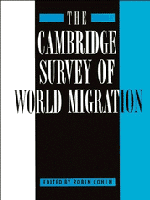Book contents
- Frontmatter
- Contents
- List of illustrations
- List of tables
- Notes on the contributors
- 1 Prologue
- 2 European colonization and settlement
- 3 Asian indentured and colonial migration
- 4 The great Atlantic migration to North America
- 5 Migration in Europe, 1800–1950
- 6 Migration in Africa
- 7 Latin and Central American migration
- 8 Migration to North America after 1945
- 9 Labour migration to western Europe after 1945
- 10 Repatriates and colonial auxiliaries
- 11 Migration in Asia and Oceania
- 12 Migration in the Middle East
- 13 Refugees from political conflict
- 14 Migrants and asylum-seekers in contemporary Europe
- 15 Emerging trends
- Acknowledgements and credits
- Index
8 - Migration to North America after 1945
Published online by Cambridge University Press: 05 December 2012
- Frontmatter
- Contents
- List of illustrations
- List of tables
- Notes on the contributors
- 1 Prologue
- 2 European colonization and settlement
- 3 Asian indentured and colonial migration
- 4 The great Atlantic migration to North America
- 5 Migration in Europe, 1800–1950
- 6 Migration in Africa
- 7 Latin and Central American migration
- 8 Migration to North America after 1945
- 9 Labour migration to western Europe after 1945
- 10 Repatriates and colonial auxiliaries
- 11 Migration in Asia and Oceania
- 12 Migration in the Middle East
- 13 Refugees from political conflict
- 14 Migrants and asylum-seekers in contemporary Europe
- 15 Emerging trends
- Acknowledgements and credits
- Index
Summary
In his classic account of migration to the USA, Oscar Handlin (1951) depicts the tensions between the acceptance of the immigrant and the growth of restrictionist sentiment among recent arrivals. Americans, he says, ‘cannot push away the heritage of having been all once strangers in the land’; nor can they ‘forget the experience of having all been rootless, adrift’. However, the ‘tiredness of the transient’ produces a counter-reaction: ‘The ideals of the nest, remembered even at the height of the flight, have triumphed. Men weary of a century or more of struggle, impatient of the constant newness, more eagerly than ever hunger for the security of belonging. Restriction becomes a part of their lives – and perhaps it must be so’ (p. 306).
One can well imagine a less flattering description of the ‘nesting’, exclusionist attitudes Handlin describes. In his still widely cited account, John Higham (1955) considered such views as examples of ‘American nativism’; others have used vaguer or cruder labels like ‘nationalism’, ‘isolationism’ or ‘racism’. One can be more or less understanding, or more or less forgiving of those who pull the ladder up after their own ascent. However, it is clear that the contradiction between implicitly or explicitly encouraging new entrants, on the one hand, and excluding, deporting or repelling them, on the other, lies at the heart of the post-war immigration history of the USA.
- Type
- Chapter
- Information
- The Cambridge Survey of World Migration , pp. 233 - 270Publisher: Cambridge University PressPrint publication year: 1995



